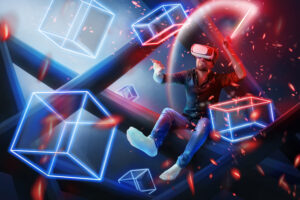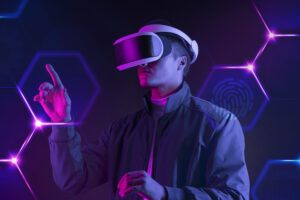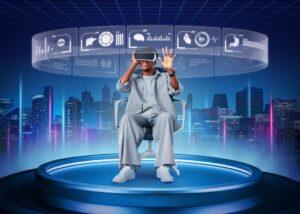 Augmented Reality(AR):
Augmented Reality(AR):AR is a technology that blends virtual aspects with the real world by superimposing digital information, such as photos, movies, or 3D models, onto the real-world environment.

AR allows users to engage with both the virtual and real worlds at the same time. The actual world is layered with digital material, allowing users to see and interact with virtual items while being aware of their surroundings.
 Augmented Reality(AR):
Augmented Reality(AR): When compared to VR, AR gives a lower degree of immersion. Users can continue to observe and interact with the actual environment while virtual content augments their perspective. AR improves but does not completely replace the previous environment.

AR offers a wide range of uses, including gaming, education, healthcare, retail, and industrial training. Pokémon Go (a smartphone game that overlays virtual animals over the actual environment), AR navigation systems, and AR-assisted medical procedures are other examples.

AR allows users to interact with both real and virtual objects. They can control virtual items, engage with virtual interfaces, and carry out real-world actions while viewing augmented information.

AR experiences are available on a variety of devices, including smartphones, tablets, smart glasses, and heads-up displays (HUDs). The hardware requirements are frequently less stringent, and some AR experiences may be accessed using commonplace devices.

Because users may see and converse with one other in the actual world while still interacting with augmented material, AR experiences can promote social connections. AR may be built to provide collaborative experiences in which several users interact with shared virtual components.

AR combines virtual and real-world content, aiming for a seamless integration of virtual and physical aspects. To preserve realism, virtual material in AR encounters is generally attached to real-world items or surfaces.

AR experiences are often more transportable and accessible on the go. AR is meant to overlay virtual items over the user’s real-world surroundings, so users may move around freely while interacting with augmented information.

AR is frequently used to augment real-world experiences by providing additional information or context. It is used in areas such as education, navigation, product visualization, and marketing, where virtual material supplements real-world interactions.
I hope that by reading this blog, you will understand how augmented reality and virtual reality are changing the way we see and interact with the world around us. AR augments our physical world by superimposing digital features, whereas VR transfers us totally into digital settings. Both technologies have enormous promise in a variety of areas, ranging from education and gaming to healthcare and retail. The final decision between AR and VR is dictated by the required level of immersion, the individual application, and the available resources.
 Interested in app or web development, but unsure how to host them? GauravGo!! is the right place for you!!!
Interested in app or web development, but unsure how to host them? GauravGo!! is the right place for you!!!
We at GauravGo strive to provide our clients with the best user experience possible, as well as a choice of hosting alternatives customized to their specific needs. With our unrivalled hosting services, created specifically for early-stage companies and students. Everyone will receive one month of free hosting and a sub-domain, as well as up to 75% more cheap hosting servers and a 3X easier-to-use interface with personalised customer assistance.
Please visit our website for further information.
Thus, we close our essay, assuming that we have covered all of the important pages related to this topic. If you believe its worth-it reading the post then do rate us. Guys, read on till then!
How useful was this post?
Click on a star to rate it!
Average rating 4.2 / 5. Vote count: 1489
No votes so far! Be the first to rate this post.
As you found this post useful...
Follow us on social media!
We are sorry that this post was not useful for you!
Let us improve this post!
Tell us how we can improve this post?